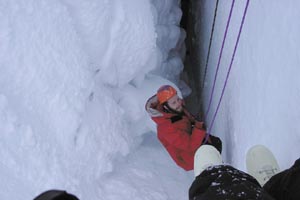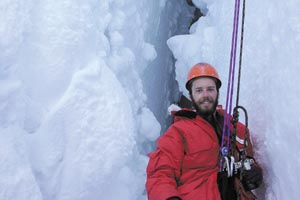Fourth-year has once-in-a-lifetime research experience studying iceberg
By Jennifer LeovyNews Office
 Fourth-year student in Geophysical Sciences Andy Bliss dangles in a crevasse on iceberg B15 in the Ross Sea. Bliss, who plans to attend graduate school at the University of California-Berkeley, worked with Douglas MacAyeal, Professor in Geophysical Sciences, while in Antarctica. |
Traversing an iceberg in Antarctica one day this winter, fourth-year Andy Bliss was in search of crevasses, deathly gaps hidden beneath the snow where a team of glaciologists planned to install a remote weather station.
Douglas MacAyeal, Professor in Geophysical Sciences, and his team prepared the equipment on an icebreaker, while Bliss, accompanied by an Antarctic mountaineer, searched for solid ice to plant their instruments on. Once a safe area was secured, the rest of the team would follow.
Bliss, a geophysical sciences concentrator, and the mountaineer were flown from the boat in a U.S. Coast Guard helicopter, from which they initially surveyed the iceberg at an altitude of 2,000 feet.
“As you travel to the iceberg there are seals basking all around, orcas bobbing up and penguins very close. It was wonderful,” said Bliss, who loves science as much as the outdoors. “When you fly out to the iceberg from the breaker, you look out, and the northern, eastern and southern horizons are occupied by the iceberg, and they are entirely white, so vast and beautiful.”
MacAyeal invited Bliss on the trip because he knew his inquisitive student was physically and mentally tough and that he would appreciate the once-in-a-lifetime experience. Bliss had proven himself elsewhere, having spent two summers in Alaska, studying glaciers in a 5,000-square-mile wilderness region.
 Andy Bliss, a fourth-year in the College, accompanied Douglas MacAyeal to Antarctica to place monitoring instruments upon the B15 iceberg in the Ross Sea. |
While there, Bliss helped a team of scientists study glacier depth, movement and snow density. He also gathered meteorological data that, in combination with other data, allows scientists to study global warming.
“Andy had experience with glaciology, working on the Juneau Icefield project. In fact, this was very important. He had proven ‘toughness reserves,’ which means I could count on his not freaking out when the helicopter left us in the white-out or when we had to build an igloo and live in it,” said MacAyeal, who first journeyed to Antarctica as a student. “And he expressed a career interest in glaciology. I wanted him to have a taste of it. It’s my duty both as a glaciologist and as a professor.”
In addition to field safety in Antarctica, Bliss was responsible for field gear, fixing occasionally sensitive equipment that ranged from circuit boards to camping stoves. His biggest task was setting up the wind-turbine power generators that MacAyeal is testing for efficacy in such harsh conditions as those in Antarctica.
Amidst blowing snow and fog, MacAyeal’s team successfully set up a weather station that will send temperature, humidity, wind velocity and global positioning system readings via satellite. The iceberg data will be analyzed back on campus during the next year.
In the meantime, Bliss has already followed his tour of Antarctica with self-guided hikes in three national parks in New Zealand, where he studied the way glaciers have carved the land. “You look at the rocks and are studying the history of the earth,” said Bliss, who said he has never pictured himself working in a lab. “I have forever loved being in the outdoors. You combine that with science, and being able to study important issues that will affect the human race, like global warming . . . This is something I really want to do.
Bliss, who plans to continue his studies at the University of California, Berkeley, said he considers himself lucky to have done such work as an undergraduate.
“It has been an honor to work with Doug MacAyeal, and the one thing about going to graduate school is that I won’t be involved in that next phase of his work. But who knows? I may be back in Antarctica during graduate school, and I am very familiar with the equipment if they need someone to check on things,” he said.
![[Chronicle]](/images/small-header.gif)